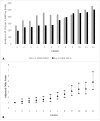Late-onset Sepsis in Extremely Premature Infants: 2000-2011
- PMID: 28709162
- PMCID: PMC5627954
- DOI: 10.1097/INF.0000000000001570
Late-onset Sepsis in Extremely Premature Infants: 2000-2011
Abstract
Background: Late-onset sepsis (LOS) is an important cause of death and neurodevelopmental impairment in premature infants. The purpose of this study was to assess overall incidence of LOS, distribution of LOS-causative organisms and center variation in incidence of LOS for extremely premature infants over time.
Methods: In a retrospective analysis of infants 401-1000 g birth weight and 22-28 6/7 weeks of gestational age born at 12 National Institute of Child Health and Human Development Neonatal Research Network centers in the years 2000-2005 (era 1) or 2006-2011 (era 2) who survived >72 hours, we compared the incidence of LOS and pathogen distribution in the 2 eras using the χ test. We also examined the effect of birth year on the incidence of LOS using multivariable regression to adjust for nonmodifiable risk factors and for center. To assess whether the incidence of LOS was different among centers in era 2, we used a multivariable regression model to adjust for nonmodifiable risk factors.
Results: Ten-thousand one-hundred thirty-one infants were studied. LOS occurred in 2083 of 5031 (41%) infants in era 1 and 1728 of 5100 (34%) infants in era 2 (P < 0.001). Birth year was a significant predictor of LOS on adjusted analysis, with birth years 2000-2009 having a significantly higher odds of LOS than the reference year 2011. Pathogens did not differ, with the exception of decreased fungal infection (P < 0.001). In era 2, 9 centers had significantly higher odds of LOS compared with the center with the lowest incidence.
Conclusions: The incidence of LOS decreased over time. Further investigation is warranted to determine which interventions have the greatest impact on infection rates.
Conflict of interest statement
Figures
References
-
- Stoll BJ, Hansen N, Fanaroff AA, et al. Late-onset sepsis in very low birth weight neonates: the experience of the NICHD Neonatal Research Network. Pediatrics. 2002;110(2 Pt 1):285–291. - PubMed
-
- Stoll BJ, Hansen NI, Adams-Chapman I, et al. Neurodevelopmental and growth impairment among extremely low-birth-weight infants with neonatal infection. JAMA. 2004;292(19):2357–2365. - PubMed
-
- Bizzarro MJ, Raskind C, Baltimore RS, Gallagher PG. Seventy-five years of neonatal sepsis at Yale: 1928–2003. Pediatrics. 2005;116(3):595–602. - PubMed
-
- Bizzarro MJ, Dembry LM, Baltimore RS, Gallagher PG. Changing patterns in neonatal Escherichia coli sepsis and ampicillin resistance in the era of intrapartum antibiotic prophylaxis. Pediatrics. 2008;121(4):689–696. - PubMed
-
- Jones AR, Kuschel C, Jacobs S, Doyle LW. Reduction in late-onset sepsis on relocating a neonatal intensive care nursery. J Paediatr Child Health. 2012;48(10):891–895. - PubMed
Publication types
MeSH terms
Grants and funding
- R01 HD081044/HD/NICHD NIH HHS/United States
- HHSN275201000003C/HD/NICHD NIH HHS/United States
- U10 HD040492/HD/NICHD NIH HHS/United States
- R18 FD005292/FD/FDA HHS/United States
- UG1 HD040492/HD/NICHD NIH HHS/United States
- UG1 HD027880/HD/NICHD NIH HHS/United States
- UG1 HD053109/HD/NICHD NIH HHS/United States
- UG1 HD027851/HD/NICHD NIH HHS/United States
- UG1 HD027904/HD/NICHD NIH HHS/United States
- HHSN275201000003I/HD/NICHD NIH HHS/United States
- T32 HD043728/HD/NICHD NIH HHS/United States
- UL1 TR001117/TR/NCATS NIH HHS/United States
LinkOut - more resources
Full Text Sources
Other Literature Sources



